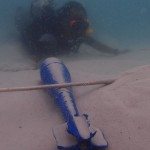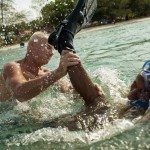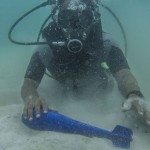Years after battles are fought and wars won, explosive ordinances and mines remain hidden in fields, forests, roads and footpaths – but they can also lie unsuspecting underwater.
US covert bombing of Cambodia during the Vietnam War in the 1970’s attributed to the sinking of 200 ammunition barges along the Mekong and Tonle Sap river systems. Many of the sunken vessels littered the water systems with tons of military ordinances from landmines, hand grenades, artillery rounds to large aircraft bombs.
These still explosive stockpiles place a significant risk to locals whose rivers act like a highway while also providing work and an income. Fishermen regularly pull up military ordinance in their nets – the devastating results for curious locals are death of loss of limbs.
“Unlike other weapons of war, landmines and unexploded ordnance are unique in that their destructiveness is indiscriminate, and long outlasts the conflicts for which they were used,” says UNICEF. They endanger generation after generation of civilians, especially children.
But their removal is a lengthy and expensive process.
While weapons cost as little as $3 each to manufacture it can cost up to $1,000 to remove them. Likewise ordinances can be spread at rates of over 1,000 per minute, but it may take a skilled expert an entire day just to clear 20-50 square meters by hand. Few of the war-torn countries most affected can afford to run clearing programs alone.
One organization is helping locals establish their own underwater bomb recovery team to rid Cambodia’s river system of life-threatening munitions. The first of it’s kind in South East Asia, the program was conceived by the Golden West Humanitarian Foundation – a non-government organization whose mission is to safeguard the lives and livelihood of men, women and children who face the dangers of these unexploded ordinances everyday.
Inspired by the work of Golden West Detective Sergeant Tony Langer of the Western Australian Police force along with fellow officers has been involved in conducting the de-mining work in Cambodia since 2008 and was part of the course to train local divers to recover and destroy these explosive remnants of war, not as simple a task as you may think, Langer explains.
“What makes operating as a diver on the Tonle Sap and Mekong river systems so difficult is that visibility underwater is zero, this combined with 40 something years of broken fishing lines, miscellaneous floating debris and fast flowing water.”
Four weeks of rigorous training, 35 eager locals – many of whom could not swim – were whittled down to 10 successful Second Class Divers.
“It’s so fulfilling to be part of something that has a real effect on people’s lives and will continue to into the future and to see the divers achieve so much has made us all proud.” Says Langer of being a part of this project.
Visit www.goldenwesthf.org for more information about the work being done in Cambodia.











